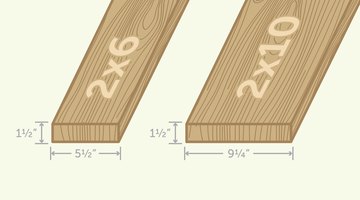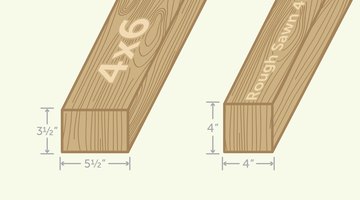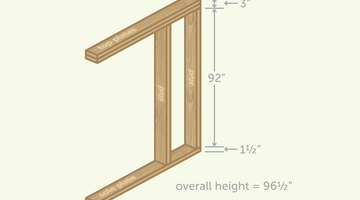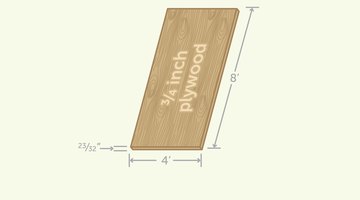Actual Sizes and Dimensions of Lumber
A two-by-six board you purchase at a home improvement center doesn’t measure 2 inches thick and 6 inches wide. Those are its nominal dimensions; its actual dimensions are smaller.

This convention dates back to the 18th century, when millers realized the effects of wood shrinkage and saw blade thickness on size measurements. They purposely milled lumber smaller than its nominal dimensions in order to standardize those dimensions, and this practice continues today.
Dimensioned Lumber

Standard dimensions for construction lumber include thicknesses of “one-by” and “two-by” and widths from two inches to 12 inches. For example, there are two-by-fours, one-by-sixes and other combinations of those numbers. In actuality, a one-by board measures only about 3/4 inch thick, and a two-by board is only about 1 1/2 inches thick. Width is slightly more variable: the rule of thumb is to subtract 1/2 for 6-inch-wide and narrower boards, and subtract 3/4 inch for 8-inch-wide and wider boards. For example, a two-by-six measures 1 1/2 inches by 5 1/2 inches; a two-by-10 board measures 1 1/2 inches by 9 1/4 inches.
Beams and Posts

Large beams and posts often are called timbers and have similar but slightly different dimensioning. Typically you reduce the stated size of beams and posts by 1/2-inch to determine their actual size. A four-by-six post measures 3 1/2 inches by 5 1/2 inches. If you are using rough-sawn, or "true dimension" timbers, however, 4 inches means 4 inches. It's important to remember this when purchasing lumber, because mixing nominal and actual dimensions can throw off your measurements and ruin your project.
Stud Lengths

"Stud" is the standard term for two-by-four framing lumber, but you have to check for length carefully when selecting studs or any two-by-fours close to 8 feet long. Some studs are sold in a range of "precut" lengths from 92 inches up to 92 5/8 inches. The idea is that when the stud is used for building a wall, the cumulative thickness of the top and bottom wall plates (horizontal members) adds 3 to 4 1/2 inches to the wall height, resulting in a total height of just over 8 feet. This makes it perfect for installing standard-size drywall sheets, leaving just a small gap along the floor. Two-by-four lumber is also sold in true 96-inch lengths and up to 16 feet, while longer boards are available through some lumberyards or special order.
Plywood Dimensions

Standard full sheets of plywood are 4 feet wide and 8 feet long and come in thicknesses ranging from 1/8 inch to 1 inch. While the nominal width and length typically are true to the actual sheet size, the thickness often varies slightly from the nominal dimension. For example, what's often called "3/4-inch" plywood actually measures 23/32 of an inch. For precise sizing when working with plywood, always measure your material, and use a scrap of the sheet to check the sizing of router grooves and other precision cuts.
The Drip Cap
- A two-by-six board you purchase at a home improvement center doesn’t measure 2 inches thick and 6 inches wide.
- Those are its nominal dimensions; its actual dimensions are smaller.
- For example, a two-by-six measures 1 1/2 inches by 5 1/2 inches; a two-by-10 board measures 1 1/2 inches by 9 1/4 inches.
- Standard full sheets of plywood are 4 feet wide and 8 feet long and come in thicknesses ranging from 1/8 inch to 1 inch.
- For precise sizing when working with plywood, always measure your material, and use a scrap of the sheet to check the sizing of router grooves and other precision cuts.
References
Resources
Writer Bio
Mike Schoonveld has been writing since 1989 with magazine credits including "Outdoor Life," "Fur-Fish-Game," "The Rotarian" and numerous regional publications. Schoonveld earned a Master Captain License from the Coast Guard. He holds a Bachelor of Science in wildlife science from Purdue University.
Photo Credits
- Dylan Blaty/Demand Media
- Dylan Blaty/Demand Media
- Dylan Blaty/Demand Media
- Dylan Blaty/Demand Media
- Dylan Blaty/Demand Media
- Dylan Blaty/Demand Media
More Articles



